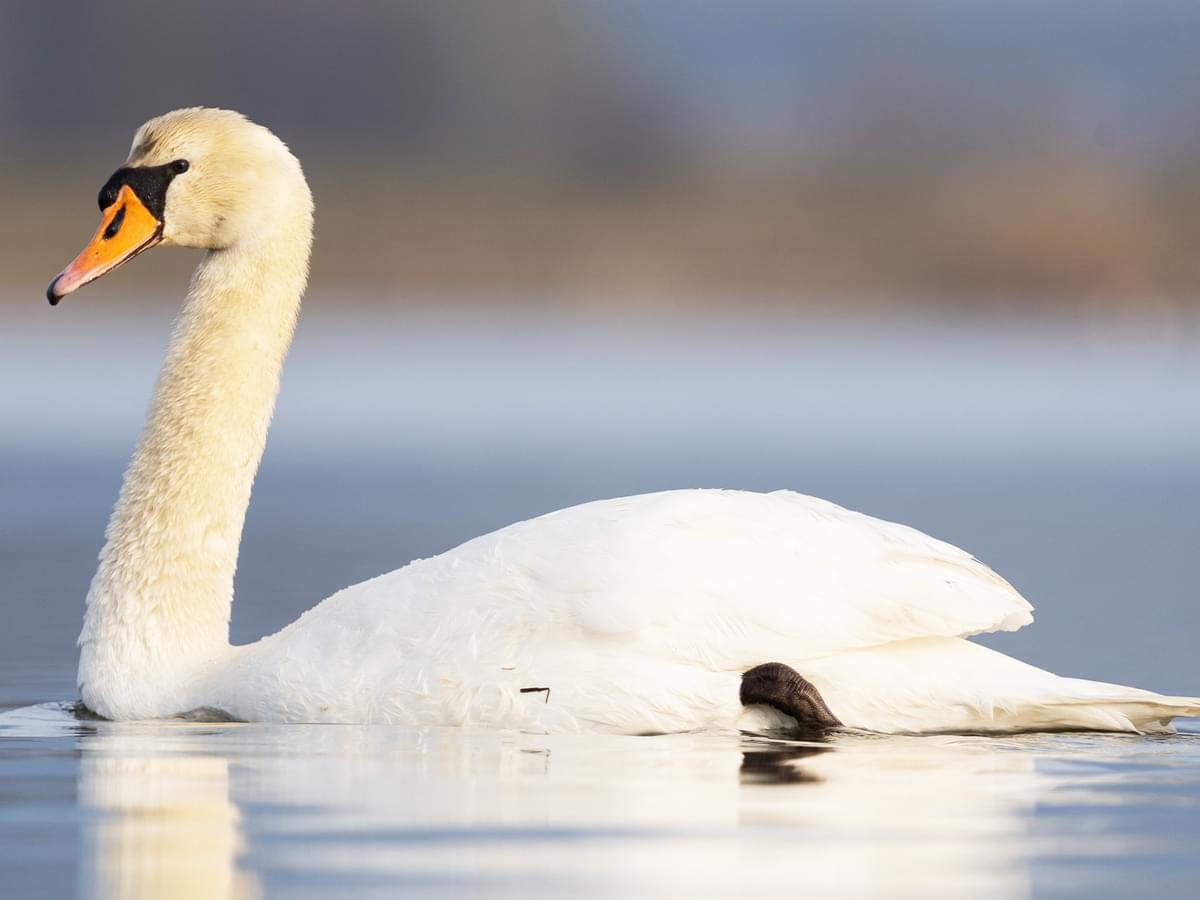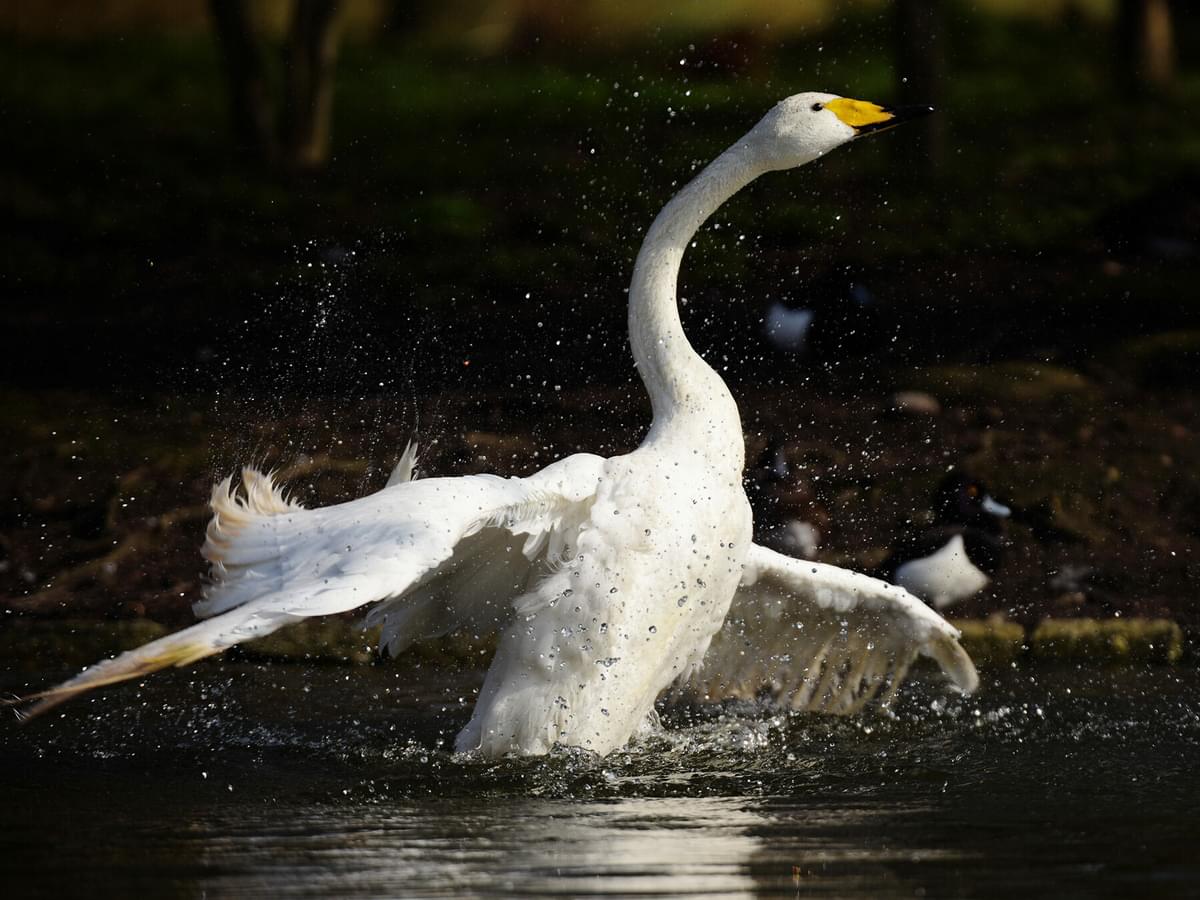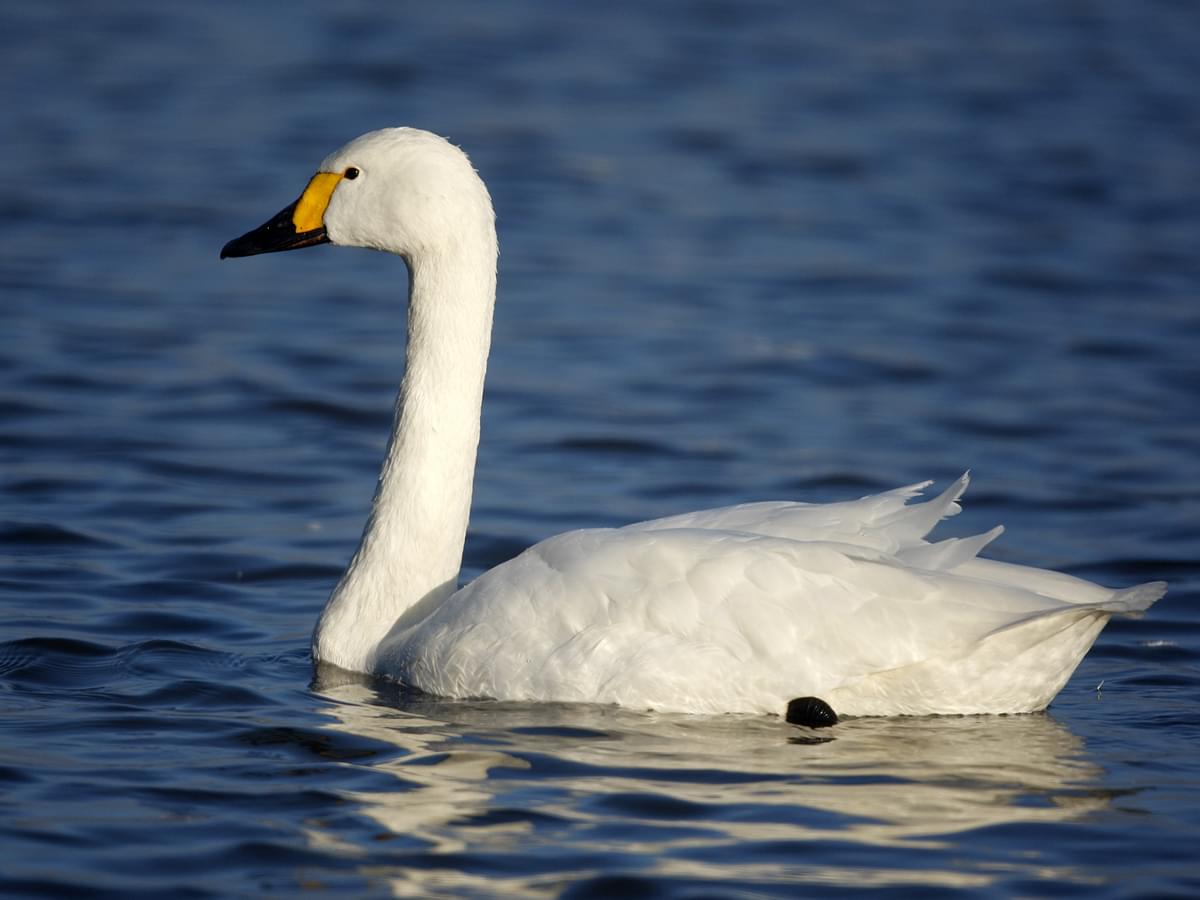Swans are emblematic, majestic, magnificent, grandiose and gracious; you’ll run out of superlatives to describe them!
These large waterbirds have featured in human myth, folklore and legend for many thousands of years and have a rather regal position in British culture courtesy of their ownership by the British Crown (in the case of Mute swans, at least).
This ancient tradition dates back to 1482 and culminates each year in the practice of Swan Upping, an annual ceremony in which Mute swans on the River Thames are ringed and released.
There are just six species of swans in the Cygnus genus of the large waterbird family Anatidae. Sometimes, seven species are described, with the Bewick’s swan sometimes classified separately as the Eurasian sister species to the Tundra swan.
The UK is home to four of six species of these gracious birds, with the Mute swan unsurprisingly being the most common.
Common Swan Species in the UK
The British swans below are generally the most likely ones you're going to spot in the UK (location dependant).
Mute Swan
Cygnus olor

Length
140-160cm
Wingspan
200-240cm
Weight
7-14kg
Mute Swan
The elegant Mute swan is named as such as it’s quieter than other species of swans. While Mute swans are hardly silent, they vocalise much less than the brazen Trumpeter swan!
Mute swans are relatively common in the UK, with around 7,000 pairs breeding here all year round, though other sources place the figure at 16,000. This accounts for about one-seventh of the global population. Resident numbers are boosted by migrants from northern Europe, particularly Scandinavia. Mute swans are the most common species of swan in the UK.
Mute swans are intelligent and intuitive birds, but they’re also capable of aggression and can be very territorial. While the saying “a swan can break your arm with a flap of its wings” is false, a Mute swan might’ve drowned a kayaker in Chicago, Illinois. Another highly aggressive Mute swan dubbed “Mr Nasty” was responsible for the deaths of some 20 swans in Pembroke, Wales. Perhaps not so gracious after all, then!
While Mute swans become aggressive in the breeding season like most birds, it's their size and power which enable them to cause serious damage. In character, Mute swans are gentle birds that form strong, monogamous bonds with their partner, engaging in a hypnotic courtship dance which sees the swans orchestrate a rhythmic song while synchronising the movement of their heads. They also grieve the loss of a mate or chick, which does appear like a genuine act of emotional pain.

Mute Swan swimming on the water
Appearance
Mute swans are massive, the heaviest swan overall. They measure around 140 to 160cm (55 to 63in) in length, but exceptional specimens have reached some 170cm. They have a wingspan of 200 to 240cm (79 to 94in).
Mute swans are exceptionally heavy, weighing from 9.2 to 14.3kg (20 to 32lb) on average. Some have been recorded weighing up to 20kg, which puts them amongst the world’s heaviest flying birds (a title Mute swans held in the 1982 Guinness Book of World Records, now probably held by the Great bustard).
Their plumage is brilliant white, and they have black faces, orange bills and a facial knob. Males and females look similar, but the male is slightly larger. The male’s black facial knob swells in the breeding season, becoming larger than the female’s.
Another fascinating feature of the Mute swan is its super-long S-shaped neck. This long neck has 23 vertebrae, which is more than most long-necked birds.
Less common Swan species in the UK
Although some of these swans can still regularly be seen, you're generally less likely to come across them than the above.
Whooper Swan
Cygnus cygnus

Length
140-165cm
Wingspan
205-275cm
Weight
7.4-14kg
Whooper Swan
Whooper swans are exceptionally uncommon residents in the UK, with just 23 or so pairs nesting in Scotland. However, in winter, as many as 11,000 individuals enter Scotland, Ireland, northern England and areas of East Anglia, sometimes venturing further south.
The Ouse Washes in Cambridgeshire and Norfolk and Loch Leven in Kinross-shire, Scotland, contain some of the highest numbers of wintering Whooper swans in the UK.
You’re most likely to see Whoopers in the UK between October and March when they arrive from Iceland. This long migratory journey sees the birds make a non-stop flight across the Atlantic ocean, a distance of some 800 to 1,400 km between Iceland, Ireland and the UK.
Whooper swans have been recorded migrating at tremendous altitudes of some 8,200m where the ambient temperature is as low as -40C. During migration, Whooper swans communicate via a series of signals that help the flock maintain high speed while ensuring no single swan becomes too tired at the front of the formation.
Needless to say, these are exceptionally tough and cold-hardy birds. They breed across much of Scandinavia, Iceland, northern Russia and northern Asia. Whooper swans are very loud, and their vocalisations are more melodic than some swans.

A pair of Whooper Swans
Appearance
Whooper swans are a similar size to Mute swans and look similar to Bewick’s or Tundra swans. They’re 140 to 165 centimetres (55 to 65in) long on average, with a wingspan of 205 to 275 cm (81 to 108in). Whooper swans have a greater wingspan than Mute swans but are slightly lighter at 7.4 to 14.0 kilograms.
These large swans are all-white, with a black bill with an orange triangle across its length. Its legs are black, and it has a long, thin neck, characteristic of a swan. Unlike Mute swans, Whooper swans lack much of a facial knob.
Tundra Swan
Cygnus columbianus

Length
120-150cm
Wingspan
168-211cm
Weight
3.7-9.6kg
Tundra Swan (Bewick's Swan)
The Tundra swan is a small, robust and hardy swan that lives in the tundra, Subarctic and Arctic.
This swan is sometimes regarded as two separate species, or otherwise, the two species are regarded as subspecies of the Tundra swan.
One subspecies is the Whistling swan of the Nearctic, which consists of North America south to northern Mexico, with Greenland. The other is the Bewick’s swan of the Palearctic, which covers Europe, all of Asia north of the Himalayas, and Africa north of the Sahara.
The Bewick’s swan has yellow patches on its beak, similar to the Whooper, which the Whistling swan usually lacks. This is the primary difference between the Whistling and Bewick’s subspecies. The Bewick’s was only recently reclassified as a subspecies of the Tundra swan, but in the UK, most literature still refers to the Bewick’s swan rather than the Tundra swan - the jury is still out on how to classify them!
The UK’s population of Tundra swans migrate here from parts of Scandinavia and northern Russia, especially Siberia. Tundra swans that breed east of the Siberian Taymyr Peninsula migrate across the Baltic Sea to Denmark, the Netherlands and the UK. They’re mainly seen in eastern England; the Severn estuary, much of Lancashire, the Ouse and Nene Washes in Norfolk and Cambridgeshire, and Slimbridge, in Gloucestershire.
The UK’s winter population of Tundra swans has declined massively over the last few decades. There are just around 4,000 to 5,000 wintering birds in the UK each year.
Tundra swans have softer, higher-pitched honking vocalisations compared to other swans.

Bewick's Swan in flight over Slimbridge, Gloucestershire
Appearance
Tundra swans are one of the smaller species of swans, but they’re still pretty large. They measure 115 to 150cm (45 to 59in) in length with a wingspan of 168 to 211 cm (66 to 83 in). They weigh between 3.4 to 9.6 kg. Females are slightly smaller than males but look similar otherwise.
The adult plumage is wholly white, the swans have black legs and a mostly black bill with patches or patterns of orange. The Bewick’s swan’s orange patches are usually more pronounced than the Whistling swan subspecies.
In the 1960s, the British conservationist Sir Peter Scott observed that every Bewick’s Swan visiting Slimbridge in Gloucestershire had a unique black and yellow pattern on its bill. Researchers used these unique patterns to identify and observe specific birds.
Black Swan
Cygnus atratus
Length:
110cm to 142cm
Wingspan:
1600cm to 2000cm
Weight:
3.7kg to 9kg
Black Swan
The Black swan is native to Australia, where it breeds primarily in the southeast and southwest regions of Australia. Despite living quite literally on the other side of the world, there have been many sightings of Black swans in the UK. Black swans in the UK are presumed to be feral escapees, that were once kept in zoos or on private grounds, etc. They were also introduced to many countries as ornamental birds in the 1800s.
In 2012, a study found there were some 37 breeding Black swans in the UK, and they’ve been sighted at over 200 locations. Black swans have been sighted regularly at Dawlish in Devon, where they’ve become the town’s emblem. Others have been spotted in Stockton on Tees, in County Durham, and Marlow, Buckinghamshire.
Despite living in Australia, the Black swan is hardy enough to live in Europe in the UK. However, Black swans have never been added to the British List of birds, as their populations aren’t thought to be sufficient enough to be self-sustaining.
Black swans are more gregarious than other swans and form large flocks of hundreds of thousands of birds. They’re similarly loud as other swans, with an array of honking, bugling and trumpeting calls in their repertoire.

Black Swan having a drink of water
Appearance
Black swans measure around 110 to 142cm (43 to 56in) in length and weigh approximately 3.7 to 9 kilograms (8.2 to 19.8lb). Their wingspan ranges between 1.6 and 2 metres (5.2 and 6.6ft). Males are slightly larger than females.
As the name suggests, the Black swan really is black, in striking contrast to other swans. They have white flight feathers, which are exposed during flight. Aside from its colour, the Black swan is certainly swan-like with a stout body and long neck. Their necks are thought to be the longest of any swan relative to their size. Their bills are a bright red with a white band across the tip.
Trumpeter Swan
Cygnus buccinator
Length:
138cm to 165cm
Wingspan:
185cm to 250cm
Weight:
7kg to 13.6kg
Trumpeter Swan
The Trumpeter swan of North America has been spotted a couple of times in the UK, including at Boyton Marshes in Suffolk, in 2014. Other sightings have been confirmed in RSPB, Topsham, South Devon and Keyhaven Marshes, in Hampshire.
There are around 27 other reliable records, though most are thought to be escapees rather than vagrants from Canada and the USA.
Trumpeters are named after their bellowing trumpeter-like call, one of the loudest calls of any bird. Their call is somewhat melodic and musical.
Appearance
Trumpeter swans are huge, measuring 138 to 180cm long. Their wingspan can reach a maximum of 250cm. Trumpeters weigh between 7 to 13.6kg (15 to 30lb), but many have been recorded exceeding 15kg.
These colossal swans are the heaviest waterfowl in existence and are the heaviest and longest birds in North America. In fact, Trumpeter swans are up there with the heaviest flying birds in the world, even rivalling the titanic Andean condor, which weighs in at up to 15kg.
Trumpeter swans have black bills, which helps distinguish them from Mute and Whooper swans.
What are swans?
Swans are large waterfowl of the waterbird family Anatidae and belong to the genus Cygnus.
All six species of swans are large birds with long S-shaped necks, large, heavy bodies and big, webbed feet. They’re amongst the heaviest flying birds in the world, in the case of the Trumpeter and Mute swans, at least. Swans are strong fliers, and some are capable of migrating thousands of miles without taking a break.
They’re related to geese and ducks, with whom they often share their habitats. Most species of swans are hardy birds that breed in the tundra, arctic and subarctic, aside from the Black swan lives almost solely in Australia and the Black-necked swan of South America.
Swans are widely distributed and are found on every continent except Africa and Antarctica. They’re absent from most tropical regions, but Black-necked swans are found on the marshes and waterways of Argentina, Chile, Paraguay, Bolivia and Brazil.
While swans are typically gentle and gracious birds, they also have a reputation for at-times extreme territorial behaviour and aggression. So while the saying “a swan will break your arm in one flap of its wings” is untrue, they’re certainly capable of inflicting damage!

Mute Swan flapping its wings
Where are the best places to see swans in the UK?
Mute swans are by far the UK’s most common species of swan and can be found all throughout the UK and Ireland.
The Swan Sanctuary in Egham, Surrey, yields what is perhaps the highest concentration of Mute swans in the UK. The London Wetlands Centre is another top spot for seeing Mute swans.
The Ouse and Nene Washes in Cambridgeshire and Norfolk are home to Mute swans, Bewick’s swans and Whooper swans, with significant populations of wintering birds visiting from October to March.
In Scotland, many of the well-known Lochs feature swans. Loch Leven and the Loch of Strathbeg are two haunts of Mute and Whooper swans. The Northern Irish coastal wetlands are an excellent place for spotting migrating Whoopers and Bewick’s swans from Iceland.
In the north of England, the Martin Mere centre in Burscough, Lancashire, features Bewick’s, Mute and Whooper swans.
Marlow and Henley-on-Thames in Buckinghamshire are (relatively) regularly blessed with rare sightings of Black swans.

A Bewick's Swan, or Tundra Swan, taking a drink of water
What is the most common swan in the UK?
The Mute swan is by far the most common swan in the UK, with a breeding population of 7,000 to 16,000 pairs.
The breeding populations of Bewick’s and Whooper swans are extremely small, as most birds arrive here exclusively in winter. As a result, the Mute swan is the only swan you can reliably see in the UK all year round.
What is the largest swan in the UK?
The Mute swan is probably the heaviest of all swans, just about edging it versus the Trumpeter swan, which has the greater wingspan.
So, the Mute swan is definitely the biggest swan in the UK the vast majority of the time. Trumpeters have only been spotted in the UK as rare vagrants or escapees from zoos or private collections.

Mute Swans are the most common and largest swans in the UK
What is the smallest swan in the UK?
The smallest swan in the UK is the Tundra swan, also known as the Bewick’s swan (which is technically a subspecies of the Tundra swan).
The Bewick’s is still a large bird, but it’s around 1/4 to 1/3rd smaller than the Mute swan.
How many types of swans are there in the UK?
There are three widely recognised species of swans in the UK; the Mute, Whooper and Bewick’s swan. Only the Mute swan has a large, well-established breeding population of those three.
The Whooper swan does breed in some parts of Scotland and northern England, whereas the Bewick’s swan is almost exclusively a winter visitor. There are small quantities of Black swans in the UK, and infrequent sightings of Trumpeter swans.

Whooper Swan rising from the water
What swans are native to the UK?
It’s difficult to determine what a ‘native’ species is, but the Mute swan is thought to have lived and evolved in the UK for over 10,000 years, and is defined as a native species.
Whooper and Tundra swans aren’t really native species, as their breeding range lies elsewhere. There are three widely recognised species of swans in the UK; the Mute, Tundra and Whooper swan.
Are swans protected in the UK?
Until 1988, it was treasonous to kill and eat Mute swans, as they were still deemed the property of the British Crown (and still are to some extent).
Today, you can no longer be hanged for catching and eating a swan, but it’s still a criminal offence under the 1981 Wildlife and Countryside Act.
Are there swans in London?
Mute swans are a common sight up and down London’s waterways, including on much of the Thames.
The Swan Sanctuary in Egham, Surrey, homes huge numbers of swans and other waterfowl, and the London Wetlands Centre is another excellent location for enjoying wildlife in the capital.
